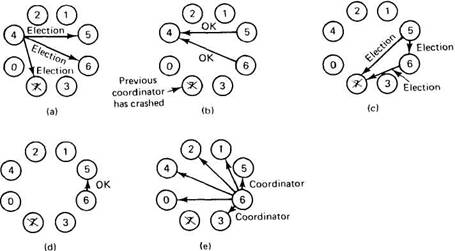Книга: Distributed operating systems
3.3.1. The Bully Algorithm
3.3.1. The Bully Algorithm
As a first example, consider the bully algorithm devised by Garcia-Molina (1982). When a process notices that the coordinator is no longer responding to requests, it initiates an election. A process, P, holds an election as follows:
1. P sends an ELECTION message to all processes with higher numbers.
2. If no one responds, P wins the election and becomes coordinator.
3. If one of the higher-ups answers, it takes over. P's job is done.
At any moment, a process can get an ELECTION message from one of its lower-numbered colleagues. When such a message arrives, the receiver sends an OK message back to the sender to indicate that he is alive and will take over. The receiver then holds an election, unless it is already holding one. Eventually, all processes give up but one, and that one is the new coordinator. It announces its victory by sending all processes a message telling them that starting immediately it is the new coordinator.
If a process that was previously down comes back up, it holds an election. If it happens to be the highest-numbered process currently running, it will win the election and take over the coordinator's job. Thus the biggest guy in town always wins, hence the name "bully algorithm."
In Fig. 3-12 we see an example of how the bully algorithm works. The group consists of eight processes, numbered from 0 to 7. Previously process 7 was the coordinator, but it has just crashed. Process 4 is the first one to notice this, so it sends ELECTION messages to all the processes higher than it, namely 5, 6, and 7, as shown in Fig. 3-12(a). Processes 5 and 6 both respond with OK, as shown in Fig. 3-12(b). Upon getting the first of these responses, 4 knows that its job is over. It knows that one of these bigwigs will take over and become coordinator. It just sits back and waits to see who the winner will be (although at this point it can make a pretty good guess).

Fig. 3-12. The bully election algorithm. (a) Process 4 holds an election. (b) Processes 5 and 6 respond, telling 4 to stop. (c) Now 5 and 6 each hold an election. (d) Process 6 tells 5 to stop. (e) Process 6 wins and tells everyone.
In Fig. 3-13(c), both 5 and 6 hold elections, each one only sending messages to those processes higher than itself. In Fig. 3-13(d) process 6 tells 5 that it will take over. At this point 6 knows that 7 is dead and that it (6) is the winner. If there is state information to be collected from disk or elsewhere to pick up where the old coordinator left off, 6 must now do what is needed. When it is ready to take over, 6 announces this by sending a COORDINATOR message to all running processes. When 4 gets this message, it can now continue with the operation it was trying to do when it discovered that 7 was dead, but using 6 as the coordinator this time. In this way the failure of 7 is handled and the work can continue.
If process 7 is ever restarted, it will just send all the others a COORDINATOR message and bully them into submission.
- 4.4.4 The Dispatcher
- About the author
- Chapter 7. The state machine
- Appendix E. Other resources and links
- Example NAT machine in theory
- The final stage of our NAT machine
- Compiling the user-land applications
- The conntrack entries
- Untracked connections and the raw table
- Basics of the iptables command
- Other debugging tools
- Setting up user specified chains in the filter table




